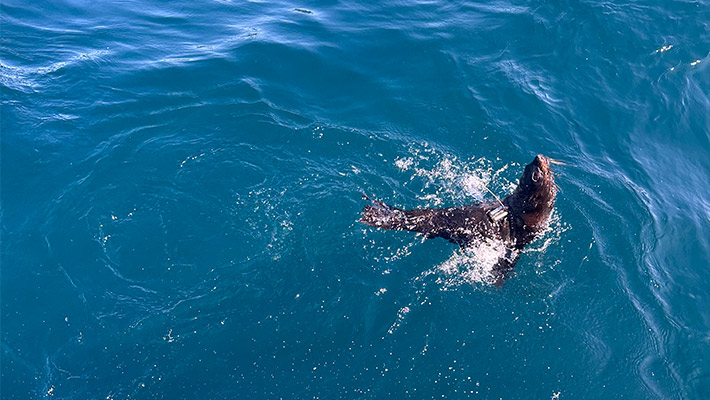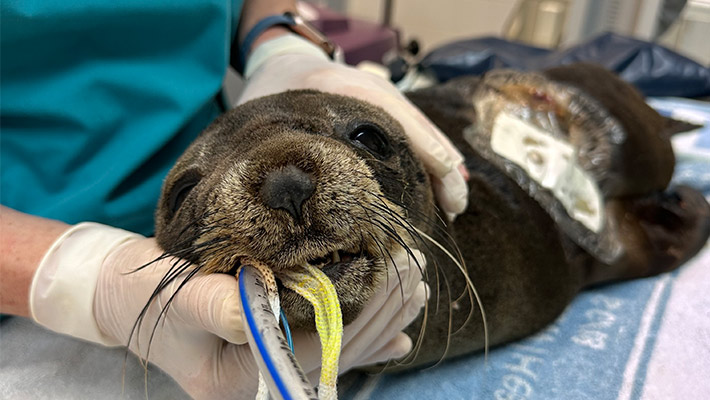Posted on 21st September 2023 by Media Relations
A third Long-nosed Fur Seal has been released and tagged as part of the NSW Government’s Seabirds to Seascapes project in a bid to help unlock precious data about how seal species are using Australian waterways.
The female Long-nosed Fur Seal who is estimated to be approximately 10 months old was found extremely lethargic and underweight along the headland of Sydney’s popular Newport Beach last month. The seal, which has been given the name ‘Narrang’ which means ‘little’ in the Sydney language (Dharug Dhalang) also had evidence of Cookiecutter shark bites.
A member of the public called ORRCA (Organisation for the Rescue and Research of Cetaceans in Australia) who then notified the NSW National Parks and Wildlife Service who collected Narrang and brought her to the Taronga Wildlife Hospital for urgent assessment and care.
“The little seal had been there all day and was easy to approach and to collect which is particularly unusual behaviour, as a healthy seal would refrain from being caught and move away from humans if approached,” said Anthony Muyt, Ranger, NSW National Parks and Wildlife Service.

Upon arrival at the Taronga Wildlife Hospital, Narrang the seal was given a general anaesthetic to allow the team to take x-rays and blood samples, while also assessing her overall health. The results were largely normal, although tests showed she was slightly anaemic.
Taronga’s Wildlife and Rehabilitation and Rescue Coordinator Libby Hall said: “For the first few days the seal was still quite weak and slept a lot and needed a lot of assistance to feed – it was touch and go. Now, after a month of being in care, her wounds have healed, her appetite is back, and she is lively again. All these signs tell us she’s ready to be released back into the wild, and there’s no better feeling,” said Hall.
Seabirds to Seascapes Senior Project Officer Kate Akkerman said: “This is the third Long-nosed Fur Seal released as part of the NSW Government’s Seabirds to Seascapes project. It is significant not only because we have a healthy seal back in the wild where she belongs, but because we have a chance to track her and see just how she uses and interacts with her environment. This is crucial information that helps us know how we can help protect these iconic species,” said Akkerman.
While Narrang’s tracking journey has only just begun, the journey of ‘Skip’ - the first seal to be released as part of Seabirds to Seascapes tracking journey has come to an end after seven illuminating months. Skip covered around 10,000km after setting off from Sydney Harbour in December last year, aged just 18 months old.

Skip’s tracker was attached to his fur coat and would have detached when he moulted in autumn. The tracker is now giving a continual signal from Hibbs Pyramid, an island on Tasmania’s west coast in the Indian Ocean.
While he was tracked, Skip swam to the edge of the sub-tropical front at the bottom of Tasmania twice before swimming to Hibbs Pyramid which is well-known for Fur Seal haul-outs and has nearby colonies.
Just two weeks ago, an eight-month-old female Long-nosed Fur Seal named ‘Felicia’ was also tracked and released as part of the project, following rehabilitation at Dolphin Marine Conservation Park in Coffs Harbour.
Felicia hit the ocean swimming after being taken out to sea in a Department of Primary Industries Fisheries boat, and within her first 24 hours was taking short swims interspersed by haul-outs around the Solitary Island Marine Park as she reacclimatises to the wild. To this day a tracking signal is still coming from this area.
Skip, Felicia and now Narrang are the first three seals to be tracked as part of the Seabirds to Seascapes project, and although it is early days for Felicia and Narrang, both journeys have been a great success and have confirmed the viability of rescuing and rehabilitating fur seals, and increased understanding of seal movements.
Taronga’s Behavioural Biologist and Conservation Researcher Dr Ben Pitcher said: “The data and insights we gain from this project are so important. Seals and humans are both lovers of the coast and sadly this brings the two species into contact and sometimes conflict, such as boat strikes and ingestion of plastics.
“By better understanding how seals are using our oceans, coasts, harbours and estuaries, we can make better decisions about how we can protect them and live more harmoniously,” said Pitcher.
The three-year Seabirds to Seascapes project is led by the NSW Department of Planning and Environment in partnership with Taronga Conservation Society Australia, NSW National Parks and Wildlife Service and the Sydney Institute of Marine Science (SIMS). The project is made possible by a $6.6 million grant from the NSW Environmental Trust.
Seals are agile and can move quickly across beaches, jetties or rocks and should not be approached. All initial assessments by licensed wildlife rehabilitators should start from the legal approach limit of 40m for a seal hauled out on land.
If you spot a sick or injured seal, please call NPWS at 1300 PARKS or ORRCA on (02) 9415 3333.